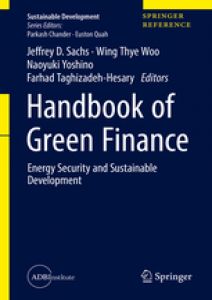

Handbook of Green Finance
This handbook deals with various financial instruments, policies, and strategies in a policy-oriented approach for financing green energy projects. Re ...
Author(s):
Summary:
This handbook deals with various financial instruments, policies, and strategies in a policy-oriented approach for financing green energy projects. Recently, global investment in renewables and energy efficiency has declined, and there is a risk that it will slow further, Clearly, fossil fuels still dominate energy investments. This trend could threaten the expansion of green energy needed to meet energy security, climate, and clean-air goals. Several developed and developing economies are still following pro-coal energy policies. The extra CO2 generated from new coal-fired power plants could more than eliminate any reductions in emissions made by other nations.
Finance is the engine of development of infrastructural projects, including energy projects. By providing several thematic and country chapters, this handbook explains that if we plan to achieve sustainable development goals, we need to create opportunities for new green projects and scale up the financing of investments that furnish environmental benefits. New financial instruments and policies such as green bonds, green banks, carbon market instruments, fiscal policy, green central banking, fintech, and community-based green funds are among the chief components that make up green finance.
Gianfranco Gianfrate contributed to the book with the chapter: 'Stimulating Non-bank Financial Institutions’ Participation in Green Investments.
This chapter analyzes the approaches adopted by institutional investors to manage climate risk in their portfolios and proposes policies to increase climate awareness in this large segment of the capital markets. Because of their size and their role as a conduit of savers’ climate concerns to the capital markets, most non-bank financial institutions are ideally positioned to steer corporate capital allocation towards more sustainable uses. Over the past decades, an increasing number of institutional investors have adopted strategies to mitigate climate exposure. These include negative screening, positive screening, active ownership, sustainability ratings, and hedging of climate risks. These strategies reflect specific fund manager mandates and the recognition that climate risks can have a tangible impact on financial assets’ valuations and, as a result, institutional fund performance. We review the evidence from the adoption of these strategies, in both advanced and developing capital markets. We then analyze the pros and cons of each strategy in promoting more sustainable climate practices and identify best practices.
Author concludes with policy recommendations for capital markets regulators to incentivize the adoption of sustainable practices among institutional investors.
Keywords
Climate risks, Asset management, Institutional investor, Carbon pricing, Sustainability
| Type : | Book |
|---|---|
| Date : | 01/01/2019 |
| Editor : | Springer Singapore |

